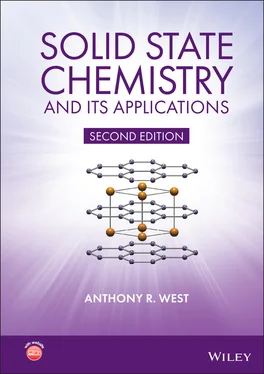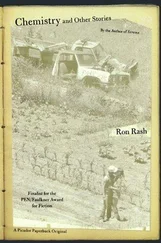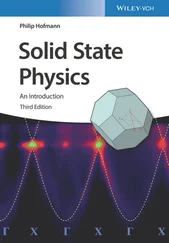Two additional complications in seeking to rationalise ordered vs disordered cation arrangements are first, many perovskites become non‐stoichiometric through oxygen loss at high temperatures. In this process, electrons are released by the O 2−/O 2reaction but are retained in the perovskite lattice and are associated with transition metal ions that therefore have a reduced valence state, leading to the mixed valence of transition metals on the B sites. Second, synthesis temperature may be important, especially if kinetically stable but thermodynamically metastable structures are obtained at moderate synthesis temperatures. There is no simple way to tell whether a particular structure is thermodynamically stable or metastable until follow‐on experiments are performed to investigate its thermal stability and possible polymorphic transitions, Chapter 7. Many cases are known in which a partially ordered or fully disordered structure may be synthesised as a consequence of the moderate synthesis temperatures or conditions that are used, although the fully ordered structure would be the true, thermodynamically stable, low temperature polymorph.
The significance of the lattice energy component associated with BB′ order in double perovskite structures is illustrated well by three Ba 2BB′O 6phases in which the BB′ combinations, and the extra lattice energy calculated to be associated with BB′ order, are: Sc IIIRe V, 594 kJ mol −1; Ni IIRe VI, 2414 kJ mol −1; Li IRe VII, 5381 kJ mol −1[data taken from Rosenstein and Schor, J. Chem. Phys . 38, 1789 (1963)]. Note, these all contain octahedrally coordinated Re but unusually, in three different valence states. The three structures have similar‐sized unit cells and therefore, charge difference rather than size difference between B and B′ appears to be the main factor that determines their increased lattice energy.
Many different structural and compositional variations are observed within the family of cation‐ordered double perovskites. The A site is frequently occupied by Ca, Sr or Ba, but the B sites may contain a wide range of, mainly transition metals, in III/V, II/VI and I/VII combinations, as shown by the above examples. The A site may also be occupied by larger, trivalent rare earth cations with II/IV BB′ combinations, as in La 2MgHfO 6and I/V, as in La 2LiIrO 6. Some compositions, such as Ba 2BiIrO 6, are polymorphic and exhibit both a cation‐disordered cubic structure at a high temperature and a non‐cubic ordered structure(s) at a lower temperature.
In addition to thermodynamic considerations of the enthalpy and entropy of possible ordered or disordered arrangements of dis‐similar cations on the B sites, tolerance factor considerations influence whether a particular structure is undistorted or tilted in some way and many non‐cubic structural variations have been found. It is difficult to give clear guidelines as to which distorted or tilted structure may form for a particular composition because other factors may also be involved, including possible oxygen non‐stoichiometry and distortions of cation‐oxygen octahedra containing either Jahn‐Teller active cations or lone pair p‐ block cations
As well as the rock salt arrangement of B site cations, other ordered arrangements occur, especially in materials in which the B:B′ ratio is different from 1:1. Ideal 1:2 double perovskites typified by Ba 3SrTa 2O 9have layered BB′ arrangements that are ordered along [111] p. The AO 3layers are separated by alternating layers of, in this case, Sr and Ta cations in octahedral sites. The ordering causes the structure to show a small rhombohedral distortion from the cubic symmetry of the parent perovskite. This ordered structure has a nine‐layer repeat consisting of six BaO 3layers, two Ta layers and one Sr layer. Other members of the 1:2 family also show partial disorder of the BB′ sites and/or various tilted arrangements. A particularly important example is PbMg 1/3Nb 2/3O 3, referred to as PMN, in which the BB′ cations are neither fully ordered nor disordered but instead, form nanoscale ordered domains within a disordered lattice, resulting in a very high and temperature‐independent permittivity, leading to applications of PMN as a relaxor ferroelectric.
The above examples concern B site order; A site order also occurs, as in NaLaMgWO 6, CaMnTi 2O 6(Mn 2+on A sites) and notably, in the oxygen‐deficient superconducting phase YBa 2Cu 3O 7, Fig., in which the Cu coordination number is reduced from 6 to a mixture of 5 and 4. A strongly tilted arrangement with 1:3 A site order is shown by CaCu 3Ti 4O 12, Section 1.17.7.4, which has aroused recent interest as a supposed ‘giant dielectric’; however, the greatly reduced tolerance factor associated with Ca and Cu as A‐site cations causes extensive tilting, leading to square planar coordination for Cu.
1.17.7.8 Hybrid organic–inorganic halide perovskites
So far, we have considered A sites to be occupied, fully or partially, by large cations such as K +, Ba 2+and La 3+. In a family of hybrid organic–inorganic perovskites, the A sites are large enough to contain ammonium, NH 4 +and small organic derivative cations such as methylammonium, MA (CH 3NH 3) +, tetramethylammonium, TMA [(CH 3) 4N] +and formamidinium, FA (NH 2=CHNH) +. The inorganic BX 3framework of corner‐sharing octahedra typically consists of the divalent cations of Ge, Sn or Pb with the larger halogens Cl, Br and I. These hybrid perovskites display a range of structural variants, including (i) tilted structures based on the BX 3octahedra and (ii) ordered arrangements, based on the non‐spherical A cations, which may undergo phase transitions to disordered cubic structures with increasing temperature. In recent years, there has been great interest in these hybrid perovskites for high efficiency, solar cell applications.
A very extensive family of hybrid layered or intergrowth perovskites has been reported which contain large organic cations that cannot fit within the A‐site cages. Instead the structures consist of BX 3layers in various orientations: [100], [110] or [111], separated by layers of organic cations. The inorganic BX 3component may be either a single layer or a multilayer block, similar to those found in the [100] orientation in the Ruddlesden–Popper family of perovskite‐rock salt intergrowth structures, Section 1.17.14. The polar, NH 3 +end of the organic component is bonded ionically to the anions of the inorganic layer and usually, the organic component consists of double layers in a head‐to‐head arrangement for bonding to the inorganic layers to either side. Given the many possible compositions for the organic component, which usually consists of chains of different lengths and with various side groups attached, there is great scope for generating novel hybrid layered perovskites. This provides one way to modify the properties that are associated primarily with the inorganic component of the structure.
1.17.7.9 Anti‐perovskites
The anti‐perovskites have the inverse of the expected cation–anion distribution. In these: X sites contain large atoms such as alkaline earth and rare earth elements; the octahedral B sites contain anions or small atomic species; a range of metallic elements or larger halogens occupy the A sites. However, it is difficult to give a description of a typical anti‐perovskite material. Some are best regarded as interstitial alloys, such as Fe 3NPt in which N occupies octahedral sites within the cubic close packed Fe 3Pt lattice. Others have metallic elements on the A sites and have properties and bonding that are intermediate between ionic and metallic, such as BiNCa 3, SnNNd 3and MgCNi 3. Another group is a range of oxy‐compounds such as Na 3OCl, K 3OBr, Ag 3IS, Ca 3NAs and Cs 3OAu. Most have undistorted cubic structures analogous to SrTiO 3, but distorted structures also occur.
Читать дальше












